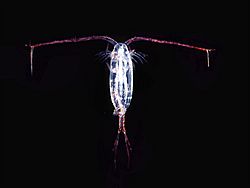Copepod facts for kids
Quick facts for kids Copepod |
|
|---|---|
 |
|
| Scientific classification | |
| Kingdom: | |
| Phylum: | |
| Subphylum: | |
| Class: | |
| Subclass: |
Copepoda
H. Milne-Edwards, 1840
|
Copepods are tiny, shrimp-like crustaceans that swim in seas, lakes, and ponds. Their name means "oar feet," which describes how they use their legs to move through the water. Even though they are very small, copepods are super important in the food web. Many animals, from small fish to large whales, eat them.
Contents
What are Copepods?
Copepods are a type of crustacean, just like crabs and shrimp. Most are only a few millimeters long, so you usually need a microscope to see them clearly. They are one of the most common animals on Earth. Billions of them swim in the water around us.
Where Do Copepods Live?
You can find copepods almost anywhere there is water! They live in salty oceans, fresh lakes, and even small ponds. They are found from the surface of the water down to the deepest parts of the ocean.
Why Are Copepods So Important?
Copepods are a key part of the food chain. They eat tiny plants called phytoplankton that float in the water. Then, many bigger animals eat the copepods. This makes them a vital link that transfers energy from tiny plants to larger animals. Without copepods, many fish and other marine animals would not have enough food to survive.
Different Kinds of Copepods
There are 10 main groups, called orders, of copepods and over 4,500 different species. Some copepods swim freely in the water. They move in jerky motions by kicking their swimming legs. Others are parasites. This means they live on or inside other animals, like fish, and get their food from them.
Images for kids
-
Copepods from Ernst Haeckel's Kunstformen der Natur
-
This slow-motion video shows a young Atlantic herring (38 mm) eating copepods. The fish approaches from below and catches each copepod. In the middle, one copepod successfully escapes to the left.
See also
 In Spanish: Copépodos para niños
In Spanish: Copépodos para niños






